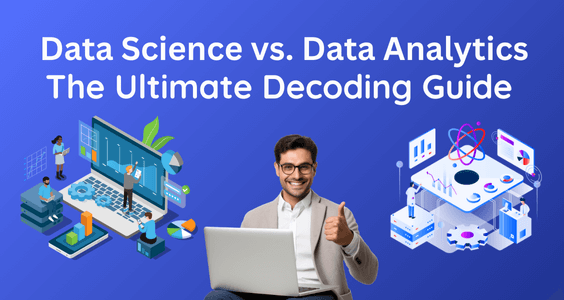The use of data analytics has become firmly established as the cornerstone of decision-making in nearly every industry. It has a wide-ranging and vital role in contemporary corporate operations and it includes everything from improving the consumer experience to streamlining the supply chain and predicting financial trends.
The importance of data-driven insights cannot be disputed in the current digital age. Advances in technology have fundamentally changed the ways we collect, examine, and use data.
This article provides a forward-looking perspective on the future of data analytics, focusing on the following:
a) Key trends
b) Emerging roles
c) Critical tools and
d) Expert predictions backed by trusted sources
The Evolution of Data Analytics Trends: A Quick Recap
Data analytics has evolved dramatically over the last decade. At the beginning of the decade (2010) Analytics was primarily used for historical reporting via spreadsheets and business intelligence dashboards. Today we see businesses using real-time and AI-enhanced analytics to make proactive decisions.
Dresner Advisory Services (2023) estimates that small businesses will achieve 59 percent penetration of business intelligence in 36 months. Organizations believe that business intelligence is essential to their present and future plans. From simple reporting to real-time strategic analysis that has a direct impact on corporate operations.
Must read for more understanding- Data Science vs. Data Analytics: The Ultimate Decoding Guide.
Emerging Trends Shaping the Future
AI-Powered & Augmented Analytics
Using natural language processing and machine learning augmented analytics facilitates data preparation and discovery. While automating the generation of insights. With the help of programs like ThoughtSpot Sage, Tableau GPT, and Power BI with Copilot, AI is already being used to provide conversational analytics.
Real-Time & Streaming Data Analysis
Real-time analytics is becoming a top priority for businesses due to the data constantly generated by IoT devices and APIs. Platforms such as Google BigQuery, Snowflake and Apache Kafka facilitate high-volume and low-latency data processing. which is crucial for sectors such as telecommunications, logistics and finance.
Data Democratization
Platforms like Looker Studio, Power BI, and Zoho Analytics, which require little or no programming, are enabling citizen analysts or non-technical individuals to create their own dashboards and reports. IDC estimates that by 2025, over 75% of employees will deal with data on a regular basis as part of their employment.
Prescriptive and Predictive Analytics
Descriptive analytics tells what happened, but predictive and prescriptive analytics tells you what will happen and what to do about it. This requires deep machine learning integration, and systems like Amazon SageMaker, Azure ML, and H2O.ai are making machine learning more widely available.
The Rise of the Hybrid Analyst
There is a growing demand for professionals who have both technical and business expertise. Roles such as analytics engineers, machine learning analysts, and data product managers bridge the gap between raw data and strategic execution.
These positions often require excellent communication skills to work with corporate stakeholders and expertise in tools such as Python, SQL, dbt, and cloud-based data pipelines.
Tools and Technologies to Watch
Some of the key Tools and technologies impacting the analytics landscape:
Cloud-native platforms: Snowflake, Google BigQuery, Amazon Redshift
Open-source frameworks: Apache Airflow, dbt, Jupyter
AI/ML integrations: Copilot in Power BI, AutoML in Google Cloud
Data visualization: Tableau, Looker, Power BI
Challenges to Anticipate
It is important to recognize that with great power comes great responsibility, which is why here are some of the challenges that data analytics will face in the future:
Data Privacy & Regulation: It is now necessary to comply with GDPR, India’s Digital Personal Data Protection Act, and other frameworks.
Unstructured Data: It can be difficult to extract valuable information from over 80% of enterprise data because it is unstructured.
Talent Gap: There is a shortage of professionals with expertise in analytics, artificial intelligence, and data engineering across the world.
Future-Proof Skills You Should Learn
To remain competitive and relevant, analysts should focus on these in-demand capabilities:
Using Python, R and SQL for Programming
For Data Engineering: dbt, Airflow, Snowflake
For Machine Learning: scikit-learn, TensorFlow, AutoML tools
For Cloud Platforms: AWS, Azure, GCP
For Soft Skills: Data storytelling, critical thinking, stakeholder communication.
According to a McKinsey & Company survey, 67% of CEOs think analytics and digital skills will be essential for any department job in the future.
Industry-Specific Predictions
Healthcare: Predictive models for early diagnosis and personalized care.
Finance: Real-time fraud detection using AI-powered analytics.
Retail: Hyper-personalized customer experiences powered by behavioral data.
Manufacturing: Predictive maintenance and supply chain optimization.
Conclusion: Embrace the Future of Analytics
Data analytics is moving away from static dashboards and moving towards dynamic with AI-powered platforms that can make decisions and derive insights on their own. Professionals in this field must be flexible and constantly upgrade their skills to stay updated with company expectations and technological advancements. Now is the time to embrace new trends and skills that will ensure your success in a data-driven future. No matter what is your experience level?

